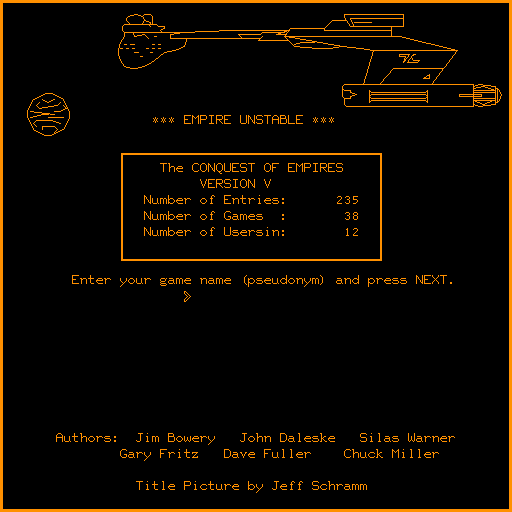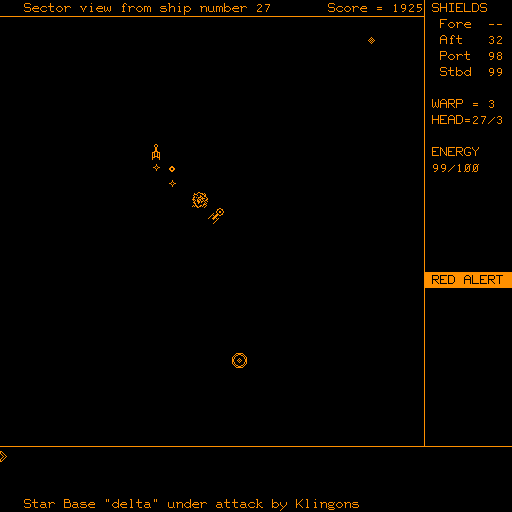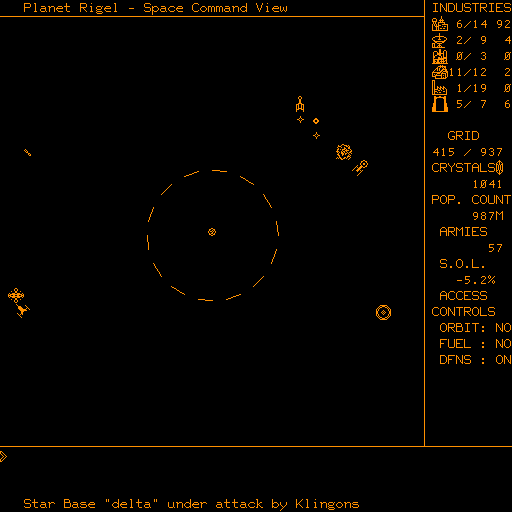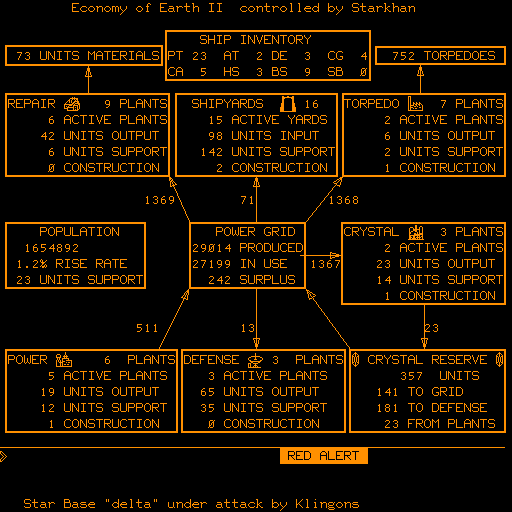PLATO Empire - The CONQUEST of EMPIRES
Empire V - Complicating for Playability
"E-conquest concerns itself with the control of planets in the EMPIRE universe. Its name derives from three sources: E(empire)-conquest: a planetary game connected with EMPIRE, E(energy)-conquest: a game involving the allocation of energy to maintain a planet. Economic-quest: a continuous quest for a stable and productive planetary economy." -- from the Empire / Conquest help pages."
During 1976 a team of us assembled (virtually) to work on taking the designs of Empire III, Empire IV (as it was), and Empire 1/Conquest to make both a 2D tactical and strategic game, "The Conquest of Empires". This team was composed of:
- Jim Bowery
- John Daleske
- Silas Warner
- Gary Fritz
- Dave Fuller
- Chuck Miller

This is a screen shot of the Empire V title page from the live PLATO system at cyber1.org. Empire V was not fully resurrected, but specific screens were re-entered.
One might ask why we wrote both Empire IV and Empire V at the same time. It was exhausting, but also exhilarating. We had a working 2D version in Empire IV, so we kept that in play while working on the much more complex Empire V.
"The population of Gygax 3, stirred to revolution by lack of decent living conditions and poverty, has revolted. An angry mob of 500,000 Terrans has stormed your headquarters, overwhelmed your guard, dragged you out, and thrown you head first into a fusion chamber."
Overview of Empire V Features:
The data for this section comes from the August 8, 1976 listing of Empire V in lesson -conquest-.
- A strategic and tactical game of
- Six (6) teams of a maximum of eighty (80) simultaneous players
- a player was an Avatar (in today's terms); one or more could be on a ship or planet
- a maximum of thirty ships of eight different ship types
- a maximum of sixty (60) active torpedoes, including mines
- in a space with thirty (30) planets with eight types of industries
- with a display of varying resolution
- ability to monitor the game
- with four scenarios: Free-for-All, King-of-the-Hill, Tournament, Team Strategic
This game greatly increased the scope of elements that were simulated.
Interaction between the two halves of the game was forced in both directions; if a ship needed repair, fuel, or more crew, it needed to dock at a star base or orbit a planet. if a planet needed more energy to build more ships, torpedoes, fuel, etc. it could get it by having the ships scout the star systems to locate dilithium crystals, returning them to the planet.
Planets needed defense from the ships; the ships needed support.
"Your population, pushed to the wall by starvation in a mismanaged economy, has revolted. A howling mob has hauled you out of the Star Council Chambers and pushed you head-first into an anti-matter reactor."
Industries, like armies, will be destroyed if your planet is bombed. This can leave you with severe shortages of materials and energy. However, shortages arising from this case may not lead to open rebellion, though armies may die from starvation as well as from bombs.

Ships status included: "check" messages, port and starboard engine status, bridge damage, life support, phasor status, photon status, communications status, and engineering. Shields were defined for each quadrant of the ship, so that a shield may be down on the port side, so the captain could rotate the ship to put a working shield in line for protection. Ships could "carry" cargo, armies, other players, and fuel.
At the right is a condensed display which indicates the status of the planetary economy and the status of the orders you have given to your defense plants. The commands used to control the game are the same whether in this display or the Economic display.

Planets had industries, armies, economies, population, power grids, and so on. A player could perform the role of a planetary leader helping the economy grow, produce more ships, more cargo, fuel, and could direct the protection of the planet with planetary defenses and alert messages to team ships. Orbital access control could be directed or put on automatic to allow fueling, beaming, and whether or not to defend.
From the Empire / Conquest help pages:
This is the display of your planetary economy. The basis of this economy is the POWER GRID. The power grid initially carries 100 energy units.
The power in your grid supports your population. One unit of power is needed for 1000 population. Population will increase as long as there is a surplus of power.
You can add extra power to your grid by consuming dilithium crystals from your reserve, but once your crystal reserve is empty, armies will begin to die on your planet.
You may also add power to the grid by building power industries. You do this by allocating some power to construction of those industries.
Eventually your construction will result in new plants which will produce power. Plants can be made inactive but their construction investment can not be recovered.
You may build up stockpiles of other materials by constructing other industries to manufacture them. But each plant requires 1000 population to maintain it.
These workers can not be retrained once they have been diverted to industry and each plant requires on unit of energy to maintain it, whether the plant is active or not.
The total system of industries, armies, power grid, stockpiles, etc. is controllable to a degree by what you do to it. But it is possible to destroy an economy.
Unless a planetary economy is kept under control, it will run riot to the ultimate destruction of the plant's armies and industries.

In the two screens above, the planetary commander can show the area of space around the planet (or star base) and direct the defense or can monitor the status of the economy, changing construction policies to increase or decrease production of photon torpedoes or ships or cystals and so on.
Planets could manufacture a variety of ship types as directed by the planetary commander. The team might interact to decide that they need more of particular types. Each ship had different characteristics:
| SHIP TYPE | NAME | Cruise Max | Phaser Banks | Photon Banks |
|---|---|---|---|---|
| PT | Patrol Boat | 7 | 2 | 2 |
| DE | Destroyer Escort | 6 | 2 | 2 |
| CG | Cruiser, Light | 6 | 2 | 2 |
| CA | Cruiser, Heavy | 6 | 3 | 2 |
| BA | Battleship | 5 | 3 | 3 |
| DR | Dreadnought | 6 | 6 | 6 |
| AT | Attack Transport | 5 | 2 | 0 |
| SB | Star Base | 2 | 7 | 2 |
The eight ships are not wholly different when the speeds and weaponry are considered. However, each has a difference in shield strength, maximum emergency warp speed, storage capacity of photons, energy, armies, and repair material, range of sensors, and finally, some have additional special features.
Empire V was designed to support voting; if a team chose to initiate a vote on preferred action to take, they would be polled and able to respond.
Ships from Line Graphics
Another great tool the PLATO Systems Programmers released in 1976 was the "lineset"; similar to a character set, but for defining a character using scalable lines. We figured if we developed a character set for smaller images and using the lineset for larger (therefore "closer") objects, we could simulate the sense of 3D. Jeff Schramm took on the project of drawing the ships from various angles. Since TUTOR allowed you to rotate the images at any angle and invert them (mirror image) many positions could be drawn with a single line character.

The character set for Empire V evolved from the earlier versions, but with added ship types crammed into each space. In addition, we expanded the "bug" ship from eight characters to sixteen to match the others so that we didn't have to do special offsets for display.
"You have decimated the population of Gygax 3, only the workers in your industries remain. Without government, without services, without armies, you and your aides sit powerless in your headquarters and slowly starve to death."
Pay No Attention to the Person Behind the Curtain
For Empire V we developed an extensive set of Operator Options, extending those of Empire III. This included being able to set up the scenarios, establishing parameters for tournaments. A scenario could be set to be open at certain times or only after a specific start time.
Teams could have initial rosters of players set or a maximum team size.
All of the objects in space could be positioned, named, and starting parameters established for each of the scenarios. Objects had initial starting settings; planets had settings for the economy, number of ships, torps, fuel, etc. in stock, the number of factories, and so on.
Industries on planets or star bases had defined characteristics, such as what they produced, how much energy was involved in production, and cost per unit of product along with the production rate. These affected how fast replacement ships could be made, or the torpedoes, or food,etc. Bombarding could affect them. If your team ran out, you would either have to scavenge or be conquered. If populations were overworked or didn't have enough food, they could strike, riot, or coup.
All of the operating parameters for the ships could be set, including cruise and maximum warps speeds, phasor strength, photon strength, the maximum view the ship can "see" (sensors), max armies it can carry, max torp capacity, cargo capacity, size of the energy bank, whether it could hyper jump, and its cost to build.
For Empire IV, many of these parameters ended up being set as constants, though behind the scenes, an operator could actually change some.
Having to replenish certain items, notably energy and photons, would have made for a more strategic game than Empire IV. You would not be able to just keep on shooting and shooting torps, for example. You have a number on board; use them up and you're more likely toasted. Players would need to head to a star base or friendly planet or coodinate with a supply ship. These supply ships would be somewhat automated, being controlled by a strategic player from a planet or star base.
Inside the Programming of Empire V
The design of Empire V was the accumulation of aspects starting way back at Empire 1 and included ideas and skills from each of the authors.
"Space" was implemented as a 20-bit signed number for X, Y, and Z coordinates. This way, all three coordinates for any object fit in a single 60-bit word.
In that space, we supported up to thirty active ships, thirty planets, sixty torpedoes and mines, and a large number of "roles", any role which could be filled by a real player or an automated player.
One complexity we had to solve for Empire V was synchronization between two different lessons on PLATO, both sharing the same common. One lesson was running the strategic level, such as the planetary commander display above, and the other lesson supported the tactical commands, shown in the sector view display above.
Messaging was an important aspect for the game, including supporting managed voting.
Another part that held a lot of my focus was how to automate the actions of ships, planets, and all when a player left the game. One would not want the ship to just disappear or a planetary economy to fail. One would prefer they keep on. Also, for inter-planetary trade the ships carrying cargo don't necessarily need a player managing them across space. I wanted a way to have a planetary commander direct a ship from planet A to star base B to resupply the base; then pick up passengers or cargo there and proceed to system C to drop them off; then return to A.
The BIG problem in all the automation was that if no user was signed in, then the lesson(s) would not be running and then time stops. Those were some of the issues we were working to solve.
See the Game Design sections, notably on Speeding It Up for some insights on how the game was made more playable.
End of an Age
I was feeling worn. I had been at Iowa State for five years working toward my triple major, working my way through with only one smaller student loan in that time. Twenty-eight credits to go.
After working on these various versions of Empire, a Dungeon game in 1975, Panzer, and other things, while there were still things to do, I needed an income. Control Data's PLATO initiative beckoned me and toward the end of August 1976, I moved to the Minneapolis, Minnesota. My interest in games continued, but subdued, designing an expanded chess game that used the processing capability of the new micro-TUTOR PLATO terminals to do the displays very fast.
After I left the effort on Empire V faded; some pieces merged back into Empire IV and others back to the aethers for others to design into their games.
In January 1977 I met Reina online on CDC PLATO; she was in Columbus, Ohio while I lived in Minneapolis, Minnesota; one of the very early long-distance online romances. That, too, was so unique at the time that we had a full interview from the Wall Street Journal, which was supposed to run on the front page. The article was nixed by the Control Data lawyers, again, in fear of a misstep of the Telecommunications rules.
We got married that following October.
See. There is a happy ending!